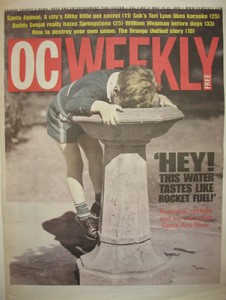 EnviroReporter.com – July 20, 2009
EnviroReporter.com – July 20, 2009
Does the state toxic department’s Aerojet Chino Hills cleanup plan go far enough? Missing munitions, untested groundwater, depleted uranium issues and radiation possibly running off the Cold War-era weapons facility into the headwaters of the Santa Ana River are concerns, even after reportedly over $46 million has been spent on cleaning up the place since we first wrote about it in 2000.
“Surrounded by barbed wire and virtually unscaleable cliffs, the Aerojet site is near the juncture of Los Angeles, Orange and San Bernardino counties,” we wrote for LA Weekly and then in a cover story for OC Weekly. “There, the firm detonated mustard- and tear-gas weapons, exploded depleted uranium-tipped projectiles, and produced a galaxy of bombs and munitions.”
After our revelations, a more intensive cleanup began covering new and previously “cleaned” sites and yielding literally tons more contamination and munitions-related debris and ordnance. Naturally, we followed developments at Aerojet Chino Hills over the years as we analyzed Aerojet-related documents and links, and were impressed by the scope of the $46 million and counting spent so far on the remediation of this 800-acre compound. Many of the unexploded bombs on the property were “BIPs” or “Blow In Place” as one of our Aerojet photo galleries shows.
In March 2009, the state Department of Toxic Substances Control, or DTSC, invited the public to a community meeting about the closure of Aerojet’s Open Burn/Open Unit detonation area. The cleanup of this 14-acre site yielded “[O]ver 260,000 cubic yards of soil were re-excavated and re-screened with over 47,000 items and 120,000 pounds of inert fragments recovered,” says DTSC’s notice of the OB/OP closure meeting.
EnviroReporter.com missed that meeting but DTSC was kind enough to send us 754 megabytes of information which we poured through. We responded with 15 pages of EnviroReporter.com comments on the cleanup plan which include our questions about the site May 1, 2009.
We asked why the groundwater under the OB/OD “unit” area hadn’t been tested for contamination or why the soil wasn’t screened for depleted-uranium toxicity. The documents supplied us suggested that all munitions and bomb-related material may not have been found at the cleanup site nor adjacent to it. We also questioned DTSC’s determination that high levels of uranium in surface and subsurface waters entering the creek that leads to the Santa Ana River were not of concern. Among many other things, we asked if the water leaving Aerojet Chino Hills wasn’t regulated by the Clean Water Act’s stringent guidelines as it is a source for water bodies used by millions for drinking water.
It has been over seven weeks since we submitted EnviroReporter.com‘s comments and questions. When DTSC responds, we will be reporting on it both here and in print.












Michael and Denise, I’ve been very impressed with your coverage of Aerojet Chino Hills since I first saw your site a few years back. Continue with the good work on this and all the other reporting you do. Congratulations on the new launch and best of luck to EnviroReporter.com, a needed resource!